Introduction
Spices serve many functions and one of the major functions of spices is its use in the food industry to infuse flavour and increased the aroma, texture and colour of food. Spices possess antimicrobial, antioxidant and protective functions for human health.1 They contain various compounds such as protein, fibre, vitamins, minerals and volatile compounds. The spices volatile compounds are important constituents and are classified according to functional groups, like alcohols, aldehydes, amines, esters, ethers, ketones, terpenes, thiols, and other miscellaneous compounds. These chemical groups have their unique characteristic aroma, taste and functional properties.2 Nigella sativa (Ranunculaceae family) seed is widely used as a spice because of its unique odour. These black seeds are small in size (1–5 mm) with corrugated integuments and have a spicy and bitter taste, making them an indispensable culinary ingredient. N. sativa seeds are usually sprinkled on Turkish bread and savoury pastries before baking to enhance the flavour and texture. The whole seeds are often dry-roasted or fried in oil to enhance its aroma, especially in Indian dishes. The seeds have also been used historically in the preparation of pickles.3-5 N. sativa can be consumed raw but is usually roasted in bakery products as roasting heightens its desirable flavour. Several researchers have investigated N. sativa for its essential oil composition.6,7
Apart from being a strong antioxidant, N. sativa seeds are one of the chief combatants of arthritis and other body system diseases. When consumed as a beverage, it betters the Kidney, liver, stomach, bladder, intestine, kidney, respiratory, circulatory and immune system.8 Research also abounds on the medicinal value of N. sativa seeds. They are known to prevent hepatotoxicity, diabetes and are anti-inflammatory as well as anthelminthic.9-16 Due to increased reports on the health use of these seeds, interest in developing N. sativa seeds into a powder which can compete easily against coffee in the market as an instant beverage has spiked. Various methods are involved in the conversion of N. sativa to powder; one of them is Spray drying.17 Spray drying is a commonly used method because of it produces very good quality powder from seeds that go through its process. The resultant powder also has favourable water activity and storage stability. These features are, however, highly reliant on factors such as carrier agent used, inlet air temperature and feed flow rate.18 Also, how long the powder retains quality and stability is based on the storage conditions and materials used in its packaging.
Storage conditions and packaging materials have been known to affect how long polyphenols in foods and beverages stay stable. Reports of such effects document the sensitivity of these compounds to light, oxygen, and heat during storage.19,20 Such reports also express the fact that storage under high temperatures causes a marked decrease in the antioxidant property of carrot polyphenols. Mustapha et al, (2007) found out that the total phenolic content of dates stored even at 10 °C decreased remarkably after five months of storage. Another research on capsaicinoids and antioxidants stability in paprika stored at various temperatures showed that long storage under good conditions reduced the concentration of capsaicinoids in these fruits. Dihydrocapsaicin suffered the highest loss 22. Likewise, a 35% decrease in levels of ascorbic acid in ground paprika were reported after four months of storage,23 while carotenoids and flavonoids were less affected by storage conditions.24 The paprika powder had its carotenoid content retain 83% of its original concentration when it was stored in plastic bags at 4 °C for 12 months.25 Refrigeration temperature was demonstrated to be effective in preserving the TPC, DPPH free radical scavenging activity and colour of spray dried hog plum juice powder,26 selected fruit extracts.27 For dried Piper beetle extracts, storage at low temperatures (5◦C) without exposure to natural light showed high retention of phenolic content, with equally good corresponding DPPH and antioxidant activity even after 180 days.28
In this study, it was hypothesized that the quality of spray dried Nigella sativa powder fluctuates during storage. From the secondary research done on this topic, it was discovered that there is little research that has been carried out on this topic. Hence, the objective of this study was to assess how carrier agents; maltodextrin and gum Arabic protect the quality of spray-dried N. sativa powder during a 12 months storage in low-density polyethylene bags (LDPE) at 4°C. Storage stability was assessed as changes in caffeine content, colour, moisture content, solubility capacity, bulk density, water activity, and antioxidants activity.
Materials and Methods
Materials
The source of the roasted black seeds (N. sativa) used for this analysis was a local manufacturing industry in Penang, Malaysia. The seeds were airtight packed in a container. Arabic gum and Maltodextrin were supplied by a local supplier.
Preparation of the Black Seeds and spray drying
The roasted black seeds were put in a high-speed blender and distilled water added at a ratio of 1:2 and mixed at high speed for 1 min. The mixed black seeds solution was then filtered with muslin cloth to eliminate solid particles in suspension and facilitate the passage of solution through the atomizer nozzle during the spray-drying. The carrier agent (5% (w/w) of Arabic gum or Maltodextrin) was dissolved in distilled water. The yield after spray drying will be 71% for maltodextrin and 43% for Arabic gum.
The material used for the feed was set up by blending the particular measure of transporter operator with the filtered black seed and the blend mixed tenderly all through the spray-drying process. A laboratory scale Mini Spray Dryer (Buchi B-290, AG, Switzerland), with a standard orifice of 0.7 mm in diameter was used for the spray-drying. The parameters which were used in spray dryer included aspirator (100%) and compressor (30 bar) as well as inlet temperature (130°C) and feed flow rate (7 m3/s).
Powder Storage
Powder samples were labelled as; NSP-MD (Spray dried N. sativa powder with Maltodextrin), NSP-AG (Spray dried N. sativa powder with Arabic gum) and NSP-R (N. sativa powder obtained by grinding roasted N. sativa seeds). 40 g samples of each powder were placed in LDPE bag and stored in refrigerator at 40C and RH 40-60% for 12 months. Samples were removed from storage at intervals of 0, 3, 6, 9 and 12 months and analysed.
Physicochemical Analyses
The experiments in this study utilized destructive sampling in the evaluation of quality attributes during storage.
Bulk Density
The graduated cylinder method described by Bhusari et al., (2014)29 was used in determining the bulk density of the NS powders. 1g of NS powder was carefully added into a 10ml graduated cylinder. Next, the cylinder was held and tapped 10 times on a rubber mat from a height of 15 cm. Determination of bulk density was by calculating the ratio of powder mass and volume occupied in the cylinder.
Water Activity (aw)
The Cuevas Rodriguez method was used in the determination of the water activity (aw)30 5g of the sample was moderated by tempering at 250C in an Aqua Model CX-2 hydrometer (Decagon Devices Inc., Pullman, WA, USA). Upon reaching headspace equilibrium, water activity value was read and recorded.
Moisture Content
The AOAC, (1984) oven method was used in determining the moisture content of the samples. About 2 gm N. sativa powder was weighed into moisture dish. The dish, with the powder was placed in an oven (Memmert UM600, Schwabach, Germany) and dried at 105°C for 24 h. After the oven drying was completed, calculation of moisture content was done and expressed as the percentage of original sample.31
Solubility Capacity
A modified version of the Fazaeli’s method was used in determining the solubility capacity 32. One gram of N. sativa powder was dissolved in distilled water (100mls) and agitated vigorously for 20 min until complete dissolution using a magnetic stirrer. Centrifugation of 30ml of this solution was then carried out at 3500rpm for 10 min with the aid of a Kubota 4000 centrifuge, Japan. At the end of centrifugation, 15ml of the supernatant was dried in the oven dried overnight at 60oC until it attained a constant weight. Solubility capacity (%) was determined as the ratio of solution weight to weight of NS powder.
Colour
The color of the surface of the powder, brightness (L*), redness (a*) and yellowness(b*) were estimated utilizing a UV Spectrophotometer CM-3500 (Konica Minolta Co., Osaka, Japan). The mean value out of 6 values was gotten for each sample set. Prior to analysis, calibration of the spectrophotometer was performed by covering it with a zero-calibration plate (CM-A120) and furthermore putting calibration glass for petri dish (CM-A129) on 8 mm size target mask (CM-A127). To quantify the L*, a*, and b* color values, the powder was placed on a petri dish (CM-A128) which was then covered with a black container.
Caffeine Analysis
The caffeine levels were analyzed by extracting the caffeine contents using a modified version of methods used by Atomssa and Gholap, (2011) and Belay et al., (2008).33,34 25mL of 80°C distilled water was used to dilute about 50 mg of N. sativa powder in a centrifuge tube which was then vortexed for 60 seconds. The centrifugation was done for 10 min at 3500rpm (Kubota 4000 centrifuge, Japan). After the centrifugation was completed, dichloromethane was added to the supernatant in a 20:20 volume ratio in a separating funnel for caffeine extraction. The separating funnel was then inverted three times so as to allow perfect mixing of the supernatant and dichloromethane. After that, the mixture was left to extract for 30 min. The extract was then kept in a beaker which was sealed with an aluminum foil. This extraction procedure was repeated four times, each time using 20 mL of dichloromethane. The resulting extract was measured at a wavelength of 273 nm with the UV-Visible spectrophotometer (UVmini-1240, Shimadzu Corp, Japan).
Antioxidant Properties Determination
DPPH free radical scavenging assay was used in the determination of the antioxidant properties. The sample used for phenolic content measurement was extracted and the flavonoid content and ferric reducing antioxidant power (FRAP) was done according to the method modified from Sun-Waterhouse et al., (2009).35
500mg of defatted Nigella sativa powder was mixed with 20mL of distilled water. This mixture was then shaken at 200rpm for 120 min in a centrifuge tube placed in a water bath (SW-23; Julabo, Eisenbahnstrasse 45, 77,960 Seelbach, Germany). The mixture was then centrifuged at 3500 rpm (Kubota 4000 centrifuge, Japan) for 30 min to obtain a clear supernatant. The clear supernatant was then separated and kept aside for analytic purposes. This procedure was done three times so as to ensure the replicability.
Determination of total phenolic content (TPC)
The Folin–Ciocalteu (FC) assay was used in the determination of the Total Phenolic Content (TPC) of NS powders based on a slight modification of the method by Singleton and Rossi, (1965).36
About 40 μL of extract was mixed with 3.12 mL of distilled water in an aluminum foil-wrapped test tube, followed by 200 μL of FC reagent and 600 μL 20% (w/v) sodium carbonate solution. The solution was mixed well and incubated for 30 min at 40°C in a water bath (SW-23; Julabo, Eisenbahnstrasse 45, 77,960 Seelbach, Germany).
Finally, a spectrophotometer (UVmini-1240, Shimadzu Corp, Japan) was used to measure the solution’s absorbance at 765 nm. A standard curve was prepared from a standard gallic acid solution with known concentrations (0, 80, 160, 240, 320, 400, 480 mg GAE/g). The obtained result was expressed as gallic acid equivalent (mg GAE/g sample).
Determination of DPPH free radical scavenging assay
The free radical-scavenging effect of the sample for DPPH was determined using the method illustrated by De Ancos et al., (2002).37 A small quantity of 10 μL extract was mixed with 90 μL of distilled water in a wrapped test tube containing 3.9 mL of 25 mM DPPH methanolic solution. A lid was placed and the mixture was vortexed and stored in the dark for 30 min. Absorbance was measured at 515 nm using A UV-Vis spectrophotometer (UVmini-1240, Shimadzu Corp, Japan) was used to measure the absorbance at 515nm against a blank. Absorbance values recorded and translated into percentage of DPPH inhibition according to the following equation:
% inhibition of DPPH = [(AControl-ASample)/AControl] x 100%
Where; AControl is the absorbance of the blank and ASample is the absorbance of the sample.
Determination of ferric reducing antioxidant power (FRAP) assay
The assay for total antioxidant activity of the sample was determined using Benzie and Strain’s, (1996) 38 method, with slight modifications. This antioxidant activity was evidenced by the change in color when Fe3+ ferric-TPTZ (tripyridyltrianzin) is reduced to a blue color solution (Fe2+ ferric-TPTZ). About 3.8 mL of warmed FRAP reagent at 37°C was mixed with 200 μL of extract and vortexed. After 30 min incubation in the dark at 37°C, the absorbance was read using a UVmini-1240 (Shimadzu Corp, Japan) at 593 nm against a blank. An aqueous solution of ferrous sulfate heptahydrate (FeSO4·7H2O) solution (200– 800 μmol) was used to make the standard curve. FRAP reagent was by mixing 300 mM acetate buffer (pH 3.6), 20 mM ferric (III) chloride hexahydrate (FeCl3·6H2O) and 2,4,6-tris (1-pyridyl)- 5-triazine (TPTZ) solution in 40 mM HCl to give a ratio of 10:1:1. The FRAP value was recorded in terms of ferrous equivalent (μmol/mg of the sample).
Determination of total flavonoid content (TFC)
The total flavonoid content (TFC) was determined using a colorimetric assay by Ramamoorthy and Bono, (2007) 39. A well diluted 1.5 mL extract was mixed with 1.5 mL of 2% aluminum chloride (AlCl2) in methanol and the absorbance read at 415 nm (UVmini-1240, Shimadzu Corp, Japan) against the blank, after incubating for 10 min at 37°C. The blank was prepared by replacing the extract in the mixture with distilled water. A standard curve was prepared using (-)-Epicatechin (10–90 mg/L) to calculate the TFC. TFC was recorded as mg (-)-Epicatechin equivalent (ECQ/g of sample) on the weight basis.
Statistical Analysis
Statistical analysis of the obtained data was done using the version 20 of SPSS software (IBM, Armonk, NY) for windows. The tests done were analysis of variance (ANOVA), Duncan’s post hoc test (P < 0.05) and mean standard deviation.
Results and Discussion
Bulk Density
When the storage process just started, there was no marked significant change (p>0.05) in bulk density between NSP-R and spray-dried powders (NSP-MD and NSP-AG) with values of 0.44g/ml, 0.52g/ml, and 0.52g/ml respectively (Figure 1). However, there were significantly higher amounts from our research than what was obtained from the previous research by Bhusari et al., (2014),29 which are considered a good bulk density in spray drying. For the rest of the experiment for 3, 6, 9 and 12 months, there was no marked change (p>0.05) in the bulk densities of the samples in storage.
According to Barbosa et al., (2005),40 the bulk density, among other bulk properties of a food powder, is based on the size of its constituent particles and how they are arranged. When a product has low bulk density, it has a greater volume when it is packaged. This is not desired. Also, with a low bulk density of a product, more air will pass through the product. This reduces how long the product can stay in storage due to oxidation.41,42
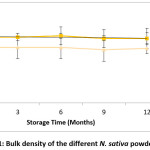 |
Figure 1: Bulk density of the different N. sativa powder samples. Click here to View figure |
Errors bars indicate mean values ± standard deviation (n=6). NSP-MD; (Spray dried roasted N. sativa seed powder coated with maltodextrin), NSP-AG; (Spray dried roasted N. sativa seed powder coated with Arabic gum) and NSP-R; (roasted N. sativa seed powder obtained by grinding).
Water Activity
From the experiment, water activity remained at viable ranges, which was 0.26 0.20 and 0.31 and for NSP-R, NSP-MD and NSP-AG respectively (Figure 2). These results were very similar to the water activity for spray dried watermelon powder values obtained by Quek et al, (2007).17 Water activity values of all samples were below 0.3 which is an indication of superior powder stability. When water activity is low, the quality of the powder will be high due to the unavailability of water for biochemical reactions, hence reducing the proliferation of microorganisms and increasing shelf life.17 Water activity increased to about 44% during the 12 months of storage for the period of the experiment.
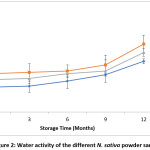 |
Figure 2: Water activity of the different N. sativa powder samples. Click here to View figure |
Errors bars indicate mean values ± standard deviation (n=6). NSP-MD; (Spray dried roasted N. sativa seed powder coated with maltodextrin), NSP-AG; (Spray dried roasted N. sativa seed powder coated with Arabic gum) and NSP-R; (roasted N. sativa seed powder obtained by grinding).
Moisture Content
Low moisture content means low water activity. Hence, it is a good measure of the stability of stored powder. When the moisture content is low, the powder is of high quality.43 Figure 3 shows the moisture content levels of the samples of spray-dried N. sativa powders (NSP-MD and NSP-AG) and NSP-R. The moisture content of spray dried NSP-AG (2.39%) was significantly higher than NSP-MD (1.12%) and NSP-R samples (1.34%). Hence, it can be concluded that the type of carrier agent had an effect on the moisture content of the N. sativa seed powder. Other past literature such as by Fazaeli et al., (2012),32 Kaur et al., (2017)44 and Kurozawa et al., (2009)42 reported similar results in Gac fruit powder, black mulberry juice powder.
The reason for the higher moisture content levels seen in NSP-AG could be because of the highly viscous nature of gum Arabic compared to maltodextrin. Hence, we can say that high viscosity means lower outlet temperature. The low temperature leads to a higher moisture content of NSP-AG. At the start of the storage period, NSP-AG showed the highest moisture content while the lowest was recorded was in NSP-MD. As the months went by, however, the NSP-MD had the highest increase in moisture content (73% in 12 months of storage) in comparison with 69% for NSP-R and 56% for NSP-AG.
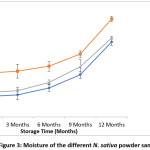 |
Figure 3: Moisture of the different N. sativa powder samples. Click here to View figure |
Errors bars indicate mean values ± standard deviation (n=6). NSP-MD; (Spray dried roasted N. sativa seed powder coated with maltodextrin), NSP-AG; (Spray dried roasted N. sativa seed powder coated with Arabic gum) and NSP-R; (roasted N. sativa seed powder obtained by grinding).
Solubility Capacity
Figure 4 show results for the solubility capacity of the study samples. A significant increase was observed in solubility capacity of NSP-R, NSP-AG and NSP-MD, which increased from 72.50% to 92.64% and 91.94% respectively. However, the solubility was not significantly different between the two samples with carrier agents. The very goal of using these two carrier agents in spray drying is to increase solubility of resulting powder which was achieved in this study. The results obtain in this study are similar to those reported by Cano-Chauca et al., (2005),45 in their study of solubility of mango juice powder spray dried using maltodextrin and gum Arabica as carrier agents. In their study, the solubility of mango juice powder spray dried without carrier agent was approximately 40%, but with carrier agents, this increased to 95%, demonstrating the effectiveness of these carrier agents in increasing solubility capacity. No significant changes were observed in solubility index during the storage duration.
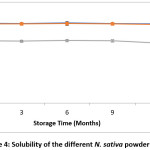 |
Figure 4: Solubility of the different N. sativa powder samples. Click here to View figure |
Errors bars indicate mean values ± standard deviation (n=6). NSP-MD; (Spray dried roasted N. sativa seed powder coated with maltodextrin), NSP-AG; (Spray dried roasted N. sativa seed powder coated with Arabic gum) and NSP-R; (roasted N. sativa seed powder obtained by grinding).
Colour
Food color is representative of food quality. Good food color makes it more attractive and seems more qualitative. It makes consumers feel the food is rich in nutrients and that the food is close to its natural state 26,7,46. The color of the spray dried powder was monitored using the Minolta Spectrophotometer. The values for the colors were L*, a*, and b*. L* value represents the light-dark (brightness) fraction of the surface color of the powder. Table 5.1 represents the effect carrier agents had on color (L*, a* and b*) of spray dried N. sativa powder during storage. At the start of the storage period, L* values were 51.09, 46.65 and 21.16 for NSP-MD, NSP-AG, and NSP-R respectively. It was noticed that both carrier agents caused an increase in the brightness of the powders.47,48 had very similar results. a* value denotes the redness of the powder, was lower in NSP-R (2.76) as compared to NSP-AG (11.83) and NSP-MD (11.15). a* values for both powders dried with carrier agent were not significantly different. Results also showed that b* value of NSP-MD and NSP-AG were significantly higher than NSP-R. The decline in color values of NSP-R could be attributed to a decrease in antioxidant activity during storage. The color stability reflected that there was a high antioxidant activity during storage. “The oxidation of carotenoids results in the formation of colorless and products such as compounds with epoxy, hydroxyl, and carbonyl groups” (Macdougall, 2002).49
Table 1: Effect of carrier agents on color parameters (L*, a* and b*) of spray dried N. sativa powder during storage.
| Color parameters | Sample | Storage duration in months | ||||
| O | 3 | 6 | 9 | 12 | ||
| L | NSP-MD | 51.09±0.96a | 50.83±0.78a | 50.40±1.37a | 49.11±0.53a | 47.75±0.95a |
| NSP-AG | 46.65±0.10b | 45.06±0.17b | 44.80±0.13b | 43.80±0.25b | 42.50±0.15b | |
| NSP-R | 21.16±0.58c | 24.18±0.47c | 30.30±0.35c | 35.25±0.58c | 30.35±0.43c | |
| a* | NSP-MD | 11.15±0.12a | 11.78±0.15a | 11.28±0.9a | 11.03±0.12a | 10.78±0.17a |
| NSP-AG | 11.83±0.16a | 11.54±0.21a | 11.07±0.19a | 10.88±0.18a | 10.12±0.22a | |
| NSP-R | 2.76±0.12b | 2.76±0.14b | 3.80±0.9b | 4.91±0.12b | 6.76±0.32b | |
| b* | NSP-MD | 34.12±0.41a | 31.18±0.33a | 35.63±0.38a | 29.11±0.41a | 25.12±0.38a |
| NSP-AG | 30.13±0.19b | 30.13±0.19b | 30.09±0.12b | 29.87±0.21b | 32.13±0.21b | |
| NSP-R | 2.15±0.11c | 2.33±0.17c | 3.23±0.19c | 4.34±0.11c | 5.15±0.17c | |
Data is presented as mean values ± standard deviation of 6 replicates (n=6). a-c Means in the same row with different letters are significantly different at (p< 0.05). NSP-MD; (Spray dried roasted N. sativa seed powder coated with maltodextrin), NSP-AG; (Spray dried roasted N. sativa seed powder coated with Arabic gum) and NSP-R; (roasted N. sativa seed powder obtained by grinding).
Caffeine Content
Caffeine is usually associated with coffee and tea, and the content is affected by variety and processes used in roasting and brewing of the tea or coffee.50 The caffeine level of freshly stored (0 months) NSP-R, NSP-MD and NSP-AG was 4.27%, 3.12% and 2.58%, respectively (Figure 5). This amount decreased significantly between 0 month and 3-month storage with min. losses of 23%, 39% and 48% in NSP-R, NSP-MD and NSP-AG samples respectively. The caffeine content continued to steadily decline during the 12 months of storage where a total loss of 70% was registered in all samples. It was observed that addition of carrier agent further promoted the decline in caffeine content as compared with NSP-R. Caffeine is a valuable constituent in beverages for human consumption because it possesses potent antioxidant properties.51 In foods; caffeine prolongs shelf life which is generally a good thing.52
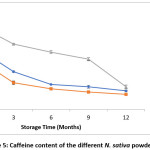 |
Figure 5: Caffeine content of the different N. sativa powder samples. Click here to View figure |
Errors bars indicate mean values ± standard deviation (n=6). NSP-MD; (Spray dried roasted N. sativa seed powder coated with maltodextrin), NSP-AG; (Spray dried roasted N. sativa seed powder coated with Arabic gum) and NSP-R; (roasted N. sativa seed powder obtained by grinding).
A slight decline in antioxidant activity was observed in NSP-MD. After 12 months of storage, the observed loss of antioxidant capacity was 71 %, 70 % and 67% in NSP-MD, NSP-AG and NSP-R respectively. However, in 3 months the loss in DPPH* was 33%, 28% and 30% for NSP-R, NSP-AG and NSP-MD respectively (Fig. 8), while for FRAP, it was 70% loss in NSP-MD, 72% in NSP-AG and 74% in NSP-R respectively (Fig. 9). The total antioxidant activity reduced significantly during storage for 12 months (p < 0.05), where by DPPH Loss in 12 months storage was 67% in NSP-MD and NSP-AG while for NSP-R, the loss was 70% (Fig. 8). In terms of FRAP losses of 70% in NSP-MD, 72 % in NSP-AG and 74% in NSP-R were recorded after the 12 months of storage (Fig.9). TFC loss for 12 months storage were NSP-MD 58%, NSP-AG 65% and NSP-R 61% (Fig.7). TPC loss range was between 64% in NSP-MD and NSP-R to 68 % in NSP-AG for 12 months storage (Fig.6). This loss in total anti-oxidant activity during storage maybe due to higher moisture content, especially in gum arabic compared to maltodextrin. From 0 months-3 months of storage, anti-oxidant activity of powder with gum Arabic was slightly higher than that of powder with maltodextrin. At 6 months, the amounts remained steady.
In an investigation by Munin and Edwards-Lévy, (2011),53 in which they explored the utilization of encapsulation (through spray drying or freeze drying) of naturally common polyphenolic compounds used in cosmetic products, Nutrition and welness products, they inferred that encapsulation gave strong fortification to polyphenols against deterirative conditions, for example, oxidation and degradation due to heat. The results obtained in this study on the stability of N. sativa powder phenolics in a protective enclosing within maltodextrin, appears to align with their discoveries.
One of the vital qualities of polyphenolic compounds is their antiradical property. Distinctive methods are utilized for the measurement of antioxidant capacity, for example, free radical DPPH* assay.54-56 According to Khattak et al., (2008),57 “the phenolic compounds in N. sativa are hydroxylated derivatives of benzoic and cinnamic, which contribute to overall antioxidant activities in the plant.” With their relationship to antioxidant activities, the phenolic compounds are believed to possess the ability to scavenge free radicals.58 By using higher polarity solvents in extracting phenolics compounds, high concentration of phenolic components will be yielded. For example, distilled water extract system can achieve a higher yield of phenolic compound than methanol/water extract system.57 Thus, water extraction method was chosen in this study. The most abundant flavonoids found in N. sativa are picatechin, (+)-catechin, quercetin, apigenin, amentoflavone, and flavone.7 TPC and TFC are highly degradable due to heating and oxidation.59,60 could explain significantly higher losses we recorded in total antioxidant activity of spray dried samples (NSP-AG and NSP-MD) compared to NSP-R.
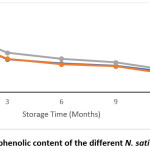 |
Figure 6: Total phenolic content of the different N. sativa powder samples. Click here to View figure |
Errors bars indicate mean values ± standard deviation (n=6). NSP-MD; (Spray dried roasted N. sativa seed powder coated with maltodextrin), NSP-AG; (Spray dried roasted N. sativa seed powder coated with Arabic gum) and NSP-R; (roasted N. sativa seed powder obtained by grinding).
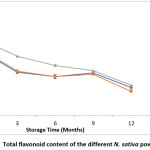 |
Figure 7: Total flavonoid content of the different N. sativa powder samples. Click here to View figure |
Errors bars indicate mean values ± standard deviation (n=6). NSP-MD; (Spray dried roasted N. sativa seed powder coated with maltodextrin), NSP-AG; (Spray dried roasted N. sativa seed powder coated with Arabic gum) and NSP-R; (roasted N. sativa seed powder obtained by grinding).
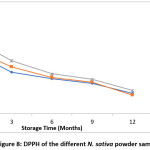 |
Figure 8: DPPH of the different N. sativa powder samples. Click here to View figure |
Errors bars indicate mean values ± standard deviation (n=6). NSP-MD; (Spray dried roasted N. sativa seed powder coated with maltodextrin), NSP-AG; (Spray dried roasted N. sativa seed powder coated with Arabic gum) and NSP-R; (roasted N. sativa seed powder obtained by grinding).
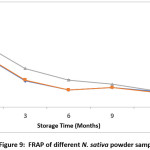 |
Figure 9: FRAP of different N. sativa powder samples. Click here to View figure |
Errors bars indicate mean values ± standard deviation (n=6). NSP-MD; (Spray dried roasted N. sativa seed powder coated with maltodextrin), NSP-AG; (Spray dried roasted N. sativa seed powder coated with Arabic gum) and NSP-R; (roasted N. sativa seed powder obtained by grinding).
Conclusion
The effectiveness of carrier agent’s maltodextrin and gum Arabic coatings in protecting caffeine, anti-oxidative compounds and functional properties of spray dried N. sativa powder as compared to uncoated roasted N. sativa powder during storage for 12 months was assessed. Storage for 12 months resulted in loss in total phenolic content (TPC) and total flavonoid content (TFC) and a decline in antioxidant activity for all samples. Overall, water activity and moisture content increased with a decrease in total antioxidant activity. This was also accompanied by a significant decrease in caffeine content. No significant changes were observed in solubility and bulk density. The colour had a positive correlation with antioxidant activity during storage. Compared to Arabic gum, the coating agent maltodextrin was thought as a good candidate for use as a coating agent for spray drying of N. sativa as evidenced by better short-term protection of caffeine, anti-oxidant and functional properties.
Acknowledgments
The authors express great appreciation to the referees for their valuable suggestions during the writing and revising of this manuscript.
Funding
This research was made possible due to the financial support the authors received in the form of fellowships from fellowship Scheme of the Institute of Postgraduate Studies, Universiti Sains Malaysia and TWAS-USM postgraduate fellowship.
Conflict of Interest
The authors have no conflict of interest to declare.
References
- Shylaja and K. V. Peter. The functional role of herbal spices. Handbook of herbs and spices. 2004; 2, 26-45.
- Parthasarathy VA, Chempakam B, Zachariah TJ. Introduction. In: Parthasarathy VA, Chempakam B, Zachariah TJ, editors. Chemistry of spice. Cambridge CABI. 2008 ;1–21.
- Ramadan M. F., Mörsel, J. T. Analysis of Glycolipids from Black Cumin (Nigella Sativa L.), Coriander (Coriandrum Sativum L.) and Niger (Guizotia Abyssinica Cass.) Oil seeds. Food Chemistry.2003; 80, 197-204.
- Malhotra SK. Nigella. In: Peter KV, editor. Handbook of herbs and spices. 1st ed. Cambridge, U.K.:Woodhead Publishing. 2004; 2,206–14.
- Raghavan S. Handbook of spices, seasoning and flavourings. 2nd ed. Boca Raton, N.Y. CRC Press Taylor and Francis group. 2007; 141.
- Burits M, Bucar F. Antioxidant activity of Nigella sativa essential oil. Phytotherapy Research, 2000; 5(14), 323–328.
- Bourgou S, Ksouri R, Bellila A, Skandrani I, Falleh H, Marzouk B. Phenolic composition and biological activities of Tunisian Nigella sativa L. shoots and roots. Comptes Rendus. 2008; 331 (1):48–55
- Janfaza, S., Janfaza E. The study of pharmacologic and medicinal valuation of thymoquinone of oil of Nigella sativa in the treatment of diseases. Annals of Biological Research.2012; 3, 1953-1957.
- Bakathir A. Abbas, N.A. Detection of the antibacterial effect of Nigella sativa ground seeds with water. Afr J Tradit Complem .2011;(8) 159.
- Chaieb , Kouidhi B., Jrah, H., Mahdouani, K. Bakhrouf, A. Antibacterial activity of Thymoquinone, an active principle of Nigella sativaand its potency to prevent bacterial biofilm formation. Afr J Tradit Complem, .2011; 11 (1):29
- Cheikh-Rouhou, S., Besbes, S., Hentati B., Blecker, C., Deroanne, C. Attia, H. Nigella sativa L Chemical composition and physicochemical characteristics of lipid fraction. Food Che. 2007; 101 (2): 673-681.
- Morsi N.M. Antimicrobial effect of crude extracts of Nigella sativaon multiple antibiotics-resistant bacteria. Acta Microbiologica et Immunologica Hungarica, Pol. 2000;49, 63-74.
- Umar, S., Zargan, J., Umar K., Ahmad, S., Katiyar, C.K.. Khan, H.A. Modulation of the oxidative stress and inflammatory cytokine response by thymoquinone in the collagen induced arthritis in Wistar rats. Chemico-Biological Interactions. 2012; 197(1):40-46.
- Hannan, A., Saleem, S., Chaudhary, S., Barkaat, M., Arshad, M. U. Anti-bacterial activity of Nigella sativa against clinical isolates of methicillin resistant Staphylococcus aureus. J Ayub Med Coll Abbottabad. 2008; 20(3), 72-74.
- Salem, E. M., Yar, T., Bamosa, A. O., Al-Quorain, A., Yasawy, M. I., Alsulaiman, R. M., Randhawa, M. A. Comparative study of Nigella Sativa and triple therapy in eradication of Helicobacter Pylori in patients with non-ulcer dyspepsia Saudi J Biol Sci. 2010; 16(3), 61-63.
- Ahmad A, Husain A, Mujeeb M et al. A review on therapeutic potential of Nigella sativa: A miracle herb. Asian Pac J Trop Biomed. 2013;3(5):337-352. doi:10.1016/s2221-1691(13)60075-1.
- Quek, S.Y., Chok, N.K., Swedlund. The physicochemical properties of spray dried watermelon powder. Chem. Eng. Process. 2007,46: 386-392.
- Tonon R.V., Brabet, C. & Hubinger, M.D, Influence of process conditions on the physicochemical properties of acai powder produced by spray drying. Int. J. Food Eng, 2008. 88, 411-418.
- Kim, Y., Welt, B.A., Talcott S.T. The impact of packaging materials on the antioxidant phytochemical stability of aqueous infusions of green tea (Camellia sinensis) and yaupon holly (Ilex vomitoria) during cold storage. J. Agric. Food Chemistry. 2011, 59, 4676-4683.
- Talcott S.T., Howard L.R. And Brenes C.H. Antioxidant changes and sensory properties of carrot puree processed with and without periderm tissues, J. Agric. Food. Chem.2000, 48, 1315-1321.
- Mustapha, K., Selselet-Attou, G. Effect of heat treatment on polyphenol oxidase and peroxidase activities in Algerian stored dates. African Journal of Biotechnology, 2007;6, 790.
- Talcott S.T., Howard L.R. And Brenes C.H. Antioxidant changes and sensory properties of carrot puree processed with and without periderm tissues. J. Agric. Chem.2000;48(4):1315-21
- Topuz, A. ,Ozdemir, F. Influence of gamma radiation and storage on the capsaicinoids of sun-dried and dehydrated paprika. Food Chem.2004; 86, 509-515.
- Daood, H.G., Vinkler, M., Markus, F., Hebshi, E.A., Bicas, P.A. Antioxidant vitamin content of spice red pepper (paprika) as affected by technological and varietal factors. Food Chem, 1996; 15 (4): 365-372.
- Kalt, W. Effect of production and processing factors on major fruit and vegetable antioxidants. J. Food Sci. Technol.2005; 70,11-19.
- Perez-Galvez, A., Hornero-Mendez, D., Minguez-Mosquera, M.I. Stability of paprika without supplementary antioxidants during storage under industrial controlled conditions. J. Agric. Food Chem. 2009; 57, 4718-4723.
- Mishra, P., Brahma, A., Seth, D. Physicochemical, functionality and storage stability of hog plum (Spondia pinnata) juice powder produced by spray drying. J. Food Sci. Technol. 2017; 54(5) 1052-1061.
- Radovanović, B., Radovanović, A., Nikolić, V., Manojlović, N., Dimitrijević, J. Storage effect on phenolic content and antioxidant activity in selected fruit extracts. Bulgarian chemical communications. 2017;49(4) 879-883.
- Ali, A., Chong, C. H., Mah, S. H., Abdullah, L. C., Choong, T. S. Y., Chua, B. L. Impact of Storage Conditions on the Stability of Predominant Phenolic Constituents and Antioxidant Activity of Dried Piper betle Extracts. Molecules.2018; 23(05): 484.
- Bhusari, S.N., Muzaffar, K., Kumar, P. Effect of carrier agents on physical and microstructural properties of spray dried tamarind pulp powder. Powder Technol. 2014;266, 354-364.
- Rodriguez, C.E.O., Verdugo-Montoya, N.M., Angulo-Bejarano, P.I., Milan-Carrillo, J., Mora-Escobedo, R., Bello-Perez, L.A., Garzon-Tiznado J.A., Reyes-Moreno, C. Nutritional properties of tempeh flour from quality protein maize (Zea mays L.). Food Sci. Technol.2006; 39, 1072-1079.
- AOAC,1984. Official Methods of Analysis. 14th ed., Arlington,VA, USA
- Fazaeli, M., Emam-Djomeh Z., Ashtari, Ak. & Omid, M. Effect of spray drying conditions and feed composition on the physical properties of black mulberry juice powder. Food and Bioproducts Processing. 2012; 90, 667-675.
- Atomssa, T. & Gholap, A. Characterization of caffeine and determination of caffeine in tea leaves using uv-visible spectrometer. African Journal of Pure and Applied Chemistry. 2011; 5(2): 1-8.
- Belay, A., Ture K., Redi, M., Asfaw, A. Measurement of caffeine in coffee beans with UV/vis spectrometer. Food chem.2008; 108, 310-315.
- Sun-Waterhouse D., Chen J., Chuah C., Wibisono R., Melton L.D., Laing W., Skinner M.A. Kiwifruit-based polyphenols and related antioxidants for functional foods: Kiwifruit extract-enhanced gluten free bread Int. J. Food Sci. Nutr. 2009 ;60(7): 251-264.
- Singleton, V., Rossi, J.A. Colorimetry of total phenolics with phosphomolybdicphosphotungsticacid reagents. Am J Enol Viticult.1965;16, 144-158.
- De, Ancos, B., Sgroppo, S., Plaza, L., Cano M.P. Possible nutritional and health-related value promotion in orange juice preserved by high-pressure treatment. J. Sci. Food Agric.2002;82 (8): 790-796.
- Benzie, I.F., Strain, J. The ferric reducing ability of plasma (FRAP) as a measure of “antioxidant power”: The FRAP assay. Anal Biochem.1996.;239 (1): 70-76.
- Ramamoorthy, P.K., Bono, A. Antioxidant activity, total phenolic and flavonoid content of Morinda citrifolia fruit extracts from various extraction processes. Int J Eng Sci. 2007; 2, 70-80
- Barbosa-Cánovas, G.V., Ortega-Rivas, E., Juliano, P., Yan, H. Food powders: physical properties, processing, and functionality, Kluwer Academic/Plenum Publishers, New York.2005.
- Kurozawa, L.E., Park K.J.,Hubinger, M.D. Effect of carrier agents on the physicochemical properties of a spray dried chicken meat protein hydrolysate. J. Food Eng. 2000; 94, 326-333.
- Goula, A.M., Adamopoulos, K.G. Effect of maltodextrin addition during spray drying of tomato pulp in dehumidified air: ii. Powder properties. Dry Technol. 2008; 26, 726-737.
- Phisut, N. Spray drying technique of fruit juice powder: some factors influencing the properties of product. Int Food Res J.2012; 19, 1297.
- Kaur, H., Bobade, H., Singh, A., Singh, B., Sharma, S. Effect of Formulations on Functional Properties and Storage Stability of Nutritionally Enriched Multigrain Pasta. Chem. Sci. Int. J.2017;19(1), 1-9.
- Cano-Chauca, M., Stringheta, P.C., Ramos A.M. ,Cal-Vidal, J. Effect of the carriers on the microstructure of mango powder obtained by spray drying and its functional characterization. Innov Food Sci Emerg Technol.2005; 6 (4):420-428.
- Kumar, P., Mishra, H.N. Storage stability of mango soy fortified yoghurt powder in two different packaging materials: HDPP and ALP. J. Food Eng 2004; 65, 569-576.
- Tze N.L., Han, C.P., Yusof, Y.A., Ling C.N., Talib R.A., Taip F.S., Aziz M.G. Physicochemical and nutritional properties of spray-dried pitaya fruit powder as natural colorant. Food Sci. Biotechnol. 2012;21(3): 675-682.
- Fazaeli, M., Emam-Djomeh Z., Omid, M., Kalbasi-Ashtari, A. Prediction of the physicochemical properties of spray-dried black mulberry (Morusnigra) juice using artificial neural networks. Food Bioprocess Tech. 2013;6,585-590.
- Macdougall, D. B. Colour measurement of food. In: Colour in Foods: Improving Quality. D. B. MacDougall Ed. Woodhead, Cambridge. 2002;33–63.
- Bunker, M.L., Mcwilliams, M. Caffeine content of common beverages. J Am Diet Assoc. 1979;74(1):28-32.
- Lee C. Antioxidant ability of caffeine and its metabolites based on the study of oxygen radical absorbing capacity and inhibition of LDL peroxidation. Clinica Chimica Acta. 2000;295, 141-154.
- Nonthakaew A., Matan N., Aewsiri T., Matan, N. Caffeine in foods and its antimicrobial activity. Int Food Res J.2015;22, 1-9.
- Munin, M., Edwards L.F. Encapsulation of natural polyphenolic compounds; a review. Pharmaceutics. 2011; 3, 793-829.
- Kruma, Z., Karklina, D., Cinkmanis, I., Rutkovska, O. Polyphenolic composition and free radical scavenging activity of red wines available in the Latvian market. Chem Tech, 2010; 54, 56-61.
- Ou B., Huang D., Hampsch-Woodill M., Flanagan J. A., Deemer, E. K. Analysis of antioxidant activities of common vegetables employing Oxygen Radical Absorbance Capacity (ORAC) and Ferric Reducing Antioxidant Power (FRAP) assays: a comparative study. J. Agric. Food Chem.2002;50, 3122-3128.
- Stratil P., Kubá V., Fojtová J. Comparison of the phenolic content and total antioxidant activity in wines as determined by spectrophotometric methods. CJFS. 2008; 26, 242-253.
- Khattak, K.F., Simpson, T.J. Effect of gamma irradiation on the extraction yield, total phenoliccontent and free radical-scavenging activity of Nigella staiva seed. Food Chem.2008;110, 967-972.
- Škerget, M., Kotnik,P., Hadolin, M., Hraš, A.R., Simonič, M., Knez, Ž. Phenols, proanthocyanidins, flavones and flavonols in some plant materials and their antioxidant activities. Food Chem, 2005;89, 191-198.
- Fang Z., Bhandari B. Effect of spray drying and storage on the stability of bayberry polyphenols. Food Chem. 2011;129, 1139-1147.
- Patras, A., Brunton, N.P., O’donnell, C., Tiwari B. Effect of thermal processing on anthocyanin stability in foods; mechanisms and kinetics of degradation. Trends Food Sci Technol. 2010;21, 3-11.

This work is licensed under a Creative Commons Attribution 4.0 International License.







